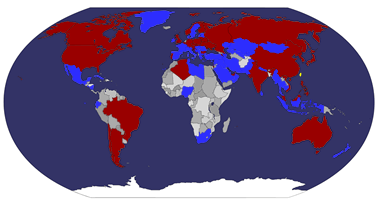
Issue date:15.04.2010
To raise understanding about our coastal wildlife and to call for the public to pay more attention to marine ecology conservation, Chunghwa Post is following up with a third set of four stamps on Taiwan’s crabs, featuring Cardisoma carnifex, Scandarma lintou, Sesarmops intermedius, and Gecarcoidea lalandii. The designs follow:
1. Cardisoma carnifex (NT$5.00): This land crab has a reddish or grayish purple carapace, yellowish cream colored abdomen and claws, and orange walking legs. It has unequal-sized claws and long, slender, flat walking legs. It burrows in swamps near estuaries, under shrubs and in the walls of fish ponds in coastal areas.
2. Scandarma lintou (NT$5.00): The color of this sesarmid crab is similar to a dry fallen leaf. It has a smooth and square carapace that is slightly wider than long. The claws are almost equal in size. With its long and slender walking legs (the third pair of which is the longest), it is an excellent tree climber. Its name is derived from the Chinese for screw pine (lintou), which is where the crab was first discovered by Dr. Liu Hung-chang.
3. Sesarmops intermedius (NT$10.00): This sesarmid crab has an almost square-shaped carapace, and slightly unequal-sized claws. Its walking legs are flat with sharp terminal joints. It is bright red to dark red in color. Therefore, it is also called Christmas crab. Every year, from May to mid-summer, when the tide is high on the Hengchun Peninsula, droves of gravid females cross coastal roads for larval release at dusk in the sea.
4. Gecarcoidea lalandii (NT$25.00): This land crab has a dark purple to reddish purple carapace, a creamy yellow abdomen, and reddish purple claws and walking legs. Its carapace is transversely ovate, with scale-like wrinkles on the sides. Its claws are equal or slightly unequal in size and its walking legs are somewhat flat. It lives in burrows in coastlines that are rocky or near coral reefs.









.jpg)























 taiwan
taiwan  cover or postcard
cover or postcard  FDC
FDC 






























































































No comments:
Post a Comment